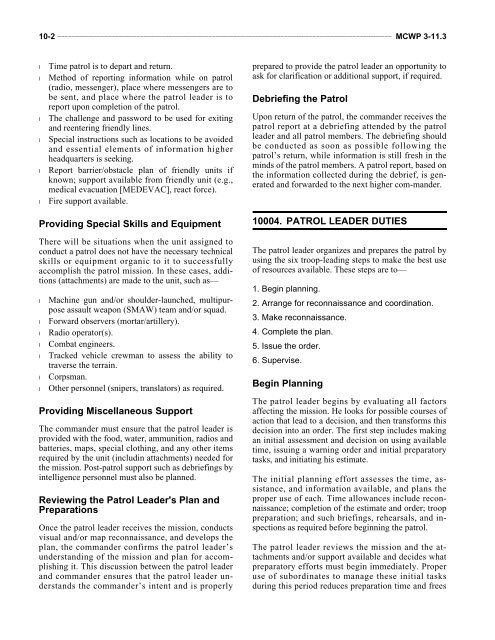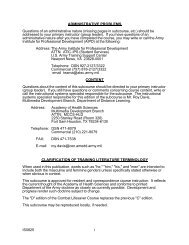10-2 _____________________________________________________________________________________________ <strong>MCWP</strong> 3-<strong>11.3</strong>l Time patrol is to depart <strong>and</strong> return.l Method of reporting information while on patrol(radio, messenger), place where messengers are tobe sent, <strong>and</strong> place where the patrol leader is toreport upon completion of the patrol.l The challenge <strong>and</strong> password to be used for exiting<strong>and</strong> reentering friendly lines.l Special instructions such as locations to be avoided<strong>and</strong> essential elements of information higherheadquarters is seeking.l Report barrier/obstacle plan of friendly units ifknown; support available from friendly unit (e.g.,medical evacuation [MEDEVAC], react force).l Fire support available.Providing Special Skills <strong>and</strong> EquipmentThere will be situations when the unit assigned toconduct a patrol does not have the necessary technicalskills or equipment organic to it to successfullyaccomplish the patrol mission. In these cases, additions(attachments) are made to the unit, such as—l Machine gun <strong>and</strong>/or shoulder-launched, multipurposeassault weapon (SMAW) team <strong>and</strong>/or squad.l Forward observers (mortar/artillery).l Radio operator(s).l Combat engineers.l Tracked vehicle crewman to assess the ability totraverse the terrain.l Corpsman.l Other personnel (snipers, translators) as required.Providing Miscellaneous SupportThe comm<strong>and</strong>er must ensure that the patrol leader isprovided with the food, water, ammunition, radios <strong>and</strong>batteries, maps, special clothing, <strong>and</strong> any other itemsrequired by the unit (includin attachments) needed forthe mission. Post-patrol support such as debriefings byintelligence personnel must also be planned.Reviewing the Patrol Leader's Plan <strong>and</strong>PreparationsOnce the patrol leader receives the mission, conductsvisual <strong>and</strong>/or map reconnaissance, <strong>and</strong> develops theplan, the comm<strong>and</strong>er confirms the patrol leader’sunderst<strong>and</strong>ing of the mission <strong>and</strong> plan for accomplishingit. This discussion between the patrol leader<strong>and</strong> comm<strong>and</strong>er ensures that the patrol leader underst<strong>and</strong>sthe comm<strong>and</strong>er’s intent <strong>and</strong> is properlyprepared to provide the patrol leader an opportunity toask for clarification or additional support, if required.Debriefing the PatrolUpon return of the patrol, the comm<strong>and</strong>er receives thepatrol report at a debriefing attended by the patrolleader <strong>and</strong> all patrol members. The debriefing shouldbe conducted as soon as possible following thepatrol’s return, while information is still fresh in theminds of the patrol members. A patrol report, based onthe information collected during the debrief, is generated<strong>and</strong> forwarded to the next higher com-m<strong>and</strong>er.10004. PATROL LEADER DUTIESThe patrol leader organizes <strong>and</strong> prepares the patrol byusing the six troop-leading steps to make the best useof resources available. These steps are to—1. Begin planning.2. Arrange for reconnaissance <strong>and</strong> coordination.3. Make reconnaissance.4. Complete the plan.5. Issue the order.6. Supervise.Begin PlanningThe patrol leader begins by evaluating all factorsaffecting the mission. He looks for possible courses ofaction that lead to a decision, <strong>and</strong> then transforms thisdecision into an order. The first step includes makingan initial assessment <strong>and</strong> decision on using availabletime, issuing a warning order <strong>and</strong> initial preparatorytasks, <strong>and</strong> initiating his estimate.The initial planning effort assesses the time, assistance,<strong>and</strong> information available, <strong>and</strong> plans theproper use of each. Time allowances include reconnaissance;completion of the estimate <strong>and</strong> order; trooppreparation; <strong>and</strong> such briefings, rehearsals, <strong>and</strong> inspectionsas required before beginning the patrol.The patrol leader reviews the mission <strong>and</strong> the attachments<strong>and</strong>/or support available <strong>and</strong> decides whatpreparatory efforts must begin immediately. Properuse of subordinates to manage these initial tasksduring this period reduces preparation time <strong>and</strong> frees
<strong>Scouting</strong> <strong>and</strong> <strong>Patrolling</strong> _________________________________________________________________________________ 10-3the patrol leader for proper planning <strong>and</strong> reconnaissance.A warning order is issued using a modifiedfive-paragraph order format (situation, mission,execution, administration <strong>and</strong> logistics, <strong>and</strong> comm<strong>and</strong><strong>and</strong> signal [SMEAC]) as a checklist. (Refer to app. Afor specific information that a patrol warning ordershould contain within each checklist item.Once the initial preparations are set in motion, thepatrol leader begins estimating by analyzing themission; considering the friendly, enemy, <strong>and</strong>operating environments; considering each course ofaction available against what the enemy might do;comparing the courses of action in terms of missionaccomplishment, capabilities, <strong>and</strong> probable casualties;<strong>and</strong> choosing one that becomes the basis for concept<strong>and</strong> order. While the patrol leader should use <strong>and</strong>organize notes, estimates must be done quickly <strong>and</strong>accurately, particularly for immediate situations. Toorganize thinking, the patrol leader uses METT-T,which consists of:l Mission—the mission assigned to the patrol <strong>and</strong>how it relates to the mission of the comm<strong>and</strong>er whois sending the patrol.l Enemy—what is known or suspected of enemypresence <strong>and</strong> capabilities, habits <strong>and</strong> characteristics,<strong>and</strong> fighting techniques.l Terrain <strong>and</strong> weather—including ground, vegetation,drainage, weather, <strong>and</strong> visibility.l Troops <strong>and</strong> support available—friendly situation<strong>and</strong> support available.l Time available—the constraints <strong>and</strong> impact of timeon preparation <strong>and</strong> mission accomplishment.The estimate begins with mission analysis, which isthe most important part of the entire planning process.Here, the patrol leader considers the specified tasks ofthe mission assigned <strong>and</strong> identifies other significantactions (specified <strong>and</strong> implied tasks) that must beundertaken to accomplish the stated mission. Thesetasks are arranged in sequence of accomplishment.The tasks <strong>and</strong> sequence create the framework fordeveloping courses of action for the patrol concept ofoperations.Arrange for Reconnaissance <strong>and</strong>CoordinationThe patrol leader arranges a personal reconnaissanceto observe as far forward as possible <strong>and</strong> alsocoordinates with the appropriate comm<strong>and</strong>ers for thepatrol’s “passage of lines” (see paragraph 11001 forcomplete definition) <strong>and</strong> supporting fires. The patrolleader also coordinates with other patrol leaders whomay be operating in the same or adjacent areas <strong>and</strong>requests that the comm<strong>and</strong>er assigning him the patrolmission coordinate the patrol action with adjacentcomm<strong>and</strong>ers, local security, <strong>and</strong> night defensive fires,as appropriate. The patrol leader may delegate any orall of these arrangements to the assistant patrol leaderif the patrol leader requires the time for planning.Make Reconnaissance <strong>and</strong> Complete theEstimateThe patrol leader uses personal reconnaissance toanswer questions that arise from the map reconnaissance<strong>and</strong> METT-T evaluation. Specific points includepassage points, lanes through obstacles,locations of friendly listening posts <strong>and</strong> observationposts, possible approach <strong>and</strong> return routes, enemypositions (if any), <strong>and</strong> intermediate observation pointson the way to the objective.In selecting approach <strong>and</strong> return routes, the patrolleader chooses routes that best use concealment <strong>and</strong>avoid opposition <strong>and</strong> obstacles. To lessen the chancesof ambush by the enemy, the return trip is plannedalong a different route. In addition to personalreconnaissance <strong>and</strong> review of the map <strong>and</strong> aerialphotographs, the advice of other patrol leaders whoalready are familiar with the terrain <strong>and</strong> the objectivearea should be considered.After compiling information about the situation <strong>and</strong>possible time constraint, the patrol leader completes anestimate. The first step is developing courses of action,each of which will provide for movement to theobjective area, mission accomplishment, <strong>and</strong> thereturn, based on the tasks <strong>and</strong> their sequencingidentified in mission analysis. While the eventualconcept of operations is presented in order ofoccurrence, the patrol leader must develop the coursesof action by either backward or forward planning. Insituations where the objective is well defined <strong>and</strong> thereis sufficient information to plan the action for missionaccomplishment (reconnaissance or combat), thepatrol leader begins the scheme for accomplishing themission at the objective <strong>and</strong> then, planning backwards,considers the options for getting there <strong>and</strong> back.The following sections on movement to <strong>and</strong> returnfrom the objective area, reconnaissance missions, <strong>and</strong>combat missions discuss methods <strong>and</strong> options availableto the patrol leader in developing the courses of



